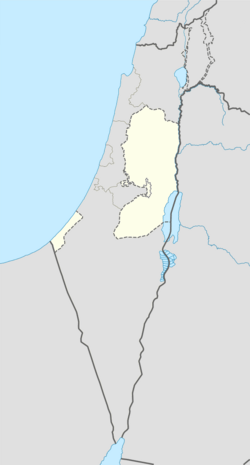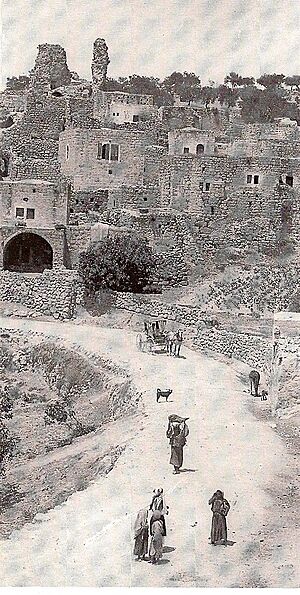Bethany facts for kids
Quick facts for kids
Bethany
|
|
|---|---|
|
Municipality type B
|
|
| Arabic transcription(s) | |
| • Arabic | العيزرية |
| • Latin | al-'Eizariya (official) al-Izzariya (unofficial) |
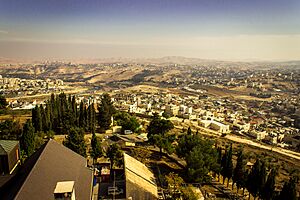
Bethany, along with Ma'ale Adumim and Az-Za'ayyem
|
|
| Country | Palestine |
| Governorate | Jerusalem |
| Government | |
| • Type | Municipality |
| Population
(2017)
|
|
| • Total | 21,175 |
| Name meaning | "The place of Lazarus" |
Bethany is a town in Palestine, close to East Jerusalem in the West Bank. Its local Arabic name is Al-Eizariya. This name means "the place of Lazarus".
According to the New Testament, Jesus brought Lazarus back to life in this town. The Tomb of Lazarus is a very important place for pilgrimage here.
Bethany is located on the southeastern side of the Mount of Olives, about 2 kilometers from Jerusalem. It is the second largest city in the Jerusalem Governorate of Palestine. In 2017, about 21,175 people lived there.
Contents
Bethany's Names and Meanings
Al-Eizariya: Place of Lazarus
The Arabic name Al-Eizariya (Arabic: العيزرية) means "place of Lazarus". In 1840, a scholar named Edward Robinson noted this. He said that the name "Bethany" was not used by the local people. However, he believed it was the same place as the Biblical Bethany.
Bethany: House of the Poor
The meaning of the name Bethany has been discussed by many experts. One idea is that it means "House of Misery" or "Poor-house". This comes from an old Syriac word.
Another idea is that it comes from a personal name like Anaiah or Ananiah. Some also think it might mean "house of figs".
However, many scholars agree with the "House of Misery" or "Poor-house" meaning. This is because old texts, like those from Jerome and early Syriac New Testaments, describe Bethany as "house of affliction" or "house of the poor". This suggests Bethany might have been a place for caring for the sick and helping those in need.
Bethany's History
Ancient Times
People have lived in Bethany since at least the 6th century BCE (Before Common Era). Some archaeologists have tried to link it to an ancient village called Ananiah.
Some experts have wondered if the current village is exactly where the ancient one was. They think the old village might have been a bit higher up the Mount of Olives. However, it is certain that the current village grew around the traditional Tomb of Lazarus. So, the area is definitely the same as the Biblical Bethany.
New Testament Stories
The New Testament describes Bethany as a small village in Judaea. It was the home of Mary of Bethany, Martha, and Lazarus of Bethany. Simon the Leper also lived there.
Jesus often stayed in Bethany, especially after visiting Jerusalem. The Bible mentions Bethany in connection with several important events:
- The famous story of Jesus raising Lazarus from the dead.
- Jesus returning to Bethany before the Passover festival.
- Jesus starting his entry into Jerusalem from near Bethany.
- Jesus staying in Bethany during the week leading up to his crucifixion.
- A dinner at Simon the Leper's house where Jesus was anointed.
- The Ascension of Jesus into heaven, which happened near Bethany.
Crusader Era (1099-1291 CE)
During the Crusades, Christian knights and settlers called the village Bethany. In 1138, King Fulk and Queen Melisende bought the village. The queen then built a large Benedictine abbey (a type of monastery) there. It was dedicated to Mary and Martha, near the Tomb of Lazarus.
Queen Melisende and her stepdaughter, Sibylla of Anjou, both died there. Melisende's granddaughter, Sibylla, who later became Queen of Jerusalem, grew up in this abbey. After Jerusalem fell in 1187, the nuns left. The village was then empty for some time.
A writer named Yaqut al-Hamawi, who lived around 1229, described Bethany as "A village near Jerusalem. There is here the tomb of Al Azar (Lazarus), whom Isa (Jesus) brought to life from being dead."
Mamluk Era (1250-1517 CE)
In the 1480s, a traveler named Felix Fabri visited Bethany. He described the houses of Mary Magdalene, Martha, and Simon the Leper. He also saw the church over Lazarus's tomb. He said the village was "well-peopled" and its residents were Muslim.
Ottoman Era (1517-1917 CE)
In 1517, Bethany became part of the Ottoman Empire. Tax records from 1596 show it had 67 Muslim families. They paid taxes on crops, vineyards, and animals.
The Ottomans built the al-Uzair Mosque, named after Lazarus. For a century, Christians were invited to worship there, but European church leaders preferred separate worship.
In 1838, Edward Robinson described it as a small, poor village with about 20 families. In 1870, it had about 113 people and 36 houses.
By 1883, the village was described as being on a hillside, with stone houses. It had the remains of a Crusader building. A mosque with a white dome was built over Lazarus's tomb. Another small mosque was dedicated to Sheik Ahmed. Around 1890, a local family, the Aburish, started promoting Bethany as a tourist spot.
By 1896, the population was about 315 people. In the early 1900s, there were about 40 family homes and 400 residents by 1917.
British Mandate Era (1920-1948 CE)
In 1922, a census showed 506 Muslims and 9 Christians living in Bethany. By 1931, the population grew to 726 people, with 715 Muslims and 11 Christians, living in 152 houses.
In 1945, the population was 1,060 people (1,040 Muslims and 20 Christians). The total land area was 11,179 dunams (a unit of land). Most of this land was used for farming.
Jordanian Era (1948-1967 CE)
After the 1948 Arab-Israeli War, Jordan controlled Bethany until 1967. In 1961, the population was 3,308.
After 1967

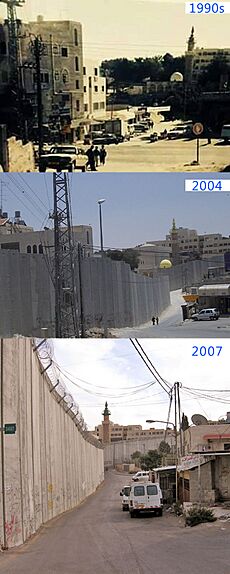
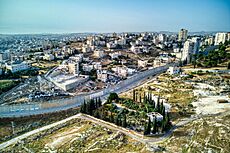
Since the Six-Day War in 1967, Israel has occupied Bethany. Land to the east of the village was made a military zone. This cut off farmers from their crops.
Today, Bethany is very crowded because its population has grown quickly. Much of the farmland has been taken or cut down by Israeli authorities. Some has also been used for new buildings in Al-Eizariya.
After the 1995 peace agreements, most of Bethany's land (87.3%) was classified as Area C. This means Israel has full control over it. The rest (12.7%) is Area B, where the Palestinian Authority has control over daily life, but Israel controls security. Israel has used land from Al-Eizariya to build two Israeli settlements: Ma'ale Adummim and Mishor Adummim.
Many original residents now live in other countries like Jordan or the United States. In 2004, the Israeli West Bank barrier was built across Bethany's main road. This has made it harder for businesses to operate.
Archaeological Discoveries
Between 1949 and 1953, archaeologists found old Christian places of worship near Lazarus's tomb. They found four churches built one on top of another, with the oldest from the 4th or 5th century. They also found ancient rock-cut tombs, house remains, wine presses, and water storage systems. Pottery found dated back to the Persian and Hellenistic periods.
Important Landmarks
Tomb of Lazarus
The Tomb of Lazarus in Bethany is a very popular place for pilgrimage. It is believed to be where Jesus brought Lazarus of Bethany back to life. This site is important to both Christians and Muslims. People have identified this cave as Lazarus's tomb since at least the 3rd century CE.
Historians from the 4th century, like Eusebius of Caesarea, mentioned the Tomb of Lazarus in this location. In 390 CE, Jerome wrote about a church dedicated to Saint Lazarus called the Lazarium.
In 1143, King Fulk and Queen Melisende bought the land and built a large Benedictine convent near the tomb. After Jerusalem fell in 1187, the convent was left empty. By 1384, a simple mosque was built on the site. In the 16th century, the Ottomans built the larger al-Uzair Mosque, named after Lazarus.
Today, the al-Uzair Mosque stands over the tomb. The Roman Catholic Church of Saint Lazarus, built between 1952 and 1955, is next to it. In 1965, a Greek Orthodox church was also built nearby.
To enter the tomb today, you go down a flight of uneven stone steps from the street. There are about twenty-four steps leading to a square room for prayer. From there, more steps lead to a lower room, which is believed to be Lazarus's tomb.
Bethany: A Place for the Poor and Sick
Some historians believe that ancient Bethany was a place where the poor and sick were cared for. The Gospels hint at this connection. For example, Mark tells of Simon the Leper's house being in Bethany. Also, Jesus received news of Lazarus's illness from Bethany.
The location of Bethany, a bit hidden from Jerusalem and the Temple Mount, might have made it suitable for caring for the sick. This would keep them "out of view" of the holy city, following ancient rules.
The Bible also mentions the poor in Bethany. When expensive perfumed oil was poured on Jesus, some disciples said it should have been sold and the money given to the poor. This might suggest a special link between Bethany and helping those in need.
It's also thought that people from Galilee might have settled in Bethany during Jesus's time. This would explain why Jesus and his disciples, who were Galileans, often stayed there when visiting Jerusalem. Bethany was the last stop for pilgrims traveling from Galilee to Jerusalem. It was a good place for a charity to help travelers and the sick.
Notable Residents
- Martha, Mary and Lazarus of Bethany, according to Christian tradition
- Said K. Aburish (1935–2012), author
- Aziz Abu Sarah (born 1980), peace activist
See also
 In Spanish: Betania para niños
In Spanish: Betania para niños


